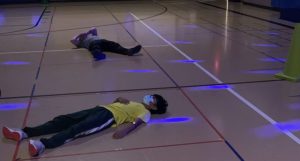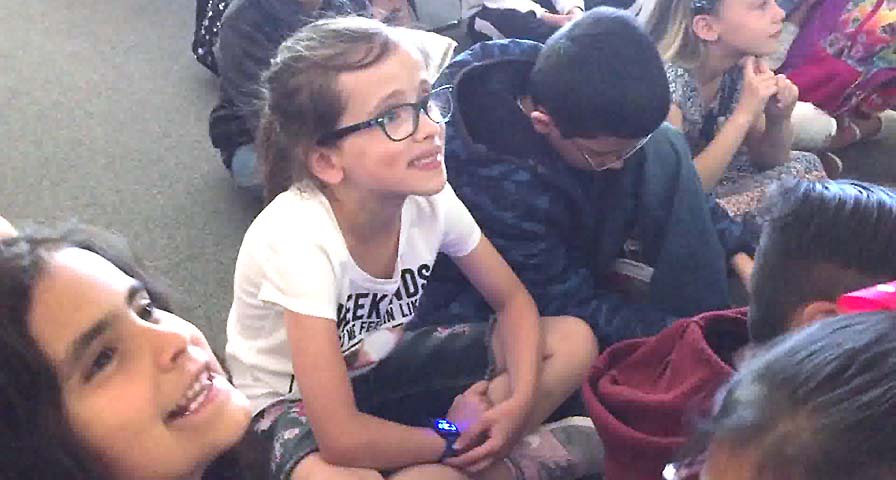Schools that use IHT ZONE heart rate monitors have a unique way to show students how their bodies respond to emotions they might feel throughout the school day.
Districts in Colorado, Minnesota, Illinois and many other states created counselor-led programs for students of all ages that use IHT’s heart rate monitors to teach students when – and how – to calm themselves down should their heart rates spike when they aren’t exercising vigorously.
“Heart rate is the most accurate and precise biomarker used to identify the severity of an emotional episode that results from stress, anxiety, trauma and other emotional triggers,” IHT Founder Jen Ohlson said.
To that end, IHT has encouraged schools – successfully – to use heart rate rate monitors to show students exactly when their heart rate spikes so they can begin to figure out what triggers them and learn to manage it with calming techniques.
Heart Rate Monitors Help Students Visualize Emotions
“We do hard work during the day,” Braham (Minn.) Area Schools counselor Jonelle Klemz said. “We have hard things going on in our lives and school. We just need some quiet time to be able to handle our feelings and manage our day.”
Klemz spends a week with each class at Braham Area Elementary School throughout the year introducing IHT ZONE heart rate monitors, breakthrough breathing and how students can recognize when they may need a break to calm themselves down. With the heart rate monitors, students see:
- Their actual heart rate;
- A color that corresponds to their heart rate zone: blue=resting heart rate; yellow=moderate heart rate; red=vigorous heart rate; and
- A graph that students their heart rate throughout the time they wear the monitor.
Klemz’s students wear the monitors throughout the school day, at the end of which she meets with each student 1:1 to review anything notable. Some of her 3rd and 4th grade students are already correlating stressful events with spikes in their heart rate.
When Klemz asked a young girl about her heart rate spiking from blue into yellow and red when she wasn’t in PE class or at recess, the student thought for a moment and then made the connection.
“She said, ‘oh, I know. That was a hard test and I wanted to do well,’” the counselor said. “Then she turns to me and asks, ‘so, is that what stress looks like?’”
To calm down when they sense – or see on the heart rate monitors — their emotions are heightened, students and teachers alike practice breathing techniques. Klemz has students work with Hoberman Spheres. Students inhale and exhale as they expand and contract the devices. They also use these breathing techniques:
- Navy Seals Box Breathing: inhale and hold for 4 seconds, exhale and hold for 4 seconds;
- 5-finger breathing: students trace their fingers as they breathe in and out; and
- Crossing arms across their midline and tapping their shoulders.
Using Colors to Identify Emotions and Maintain Self-Control
Students at Monroe Elementary in Colorado Springs, Colo., also wear IHT ZONE heart rate monitors as tools to keep their emotions – and behaviors – in check.
Counselor Maddie Francis introduced a curriculum that focuses on Zones of Regulation, which uses colors to help students visualize their objectives. She’s found it works well with the colors displayed on the IHT ZONE monitors.
“We talk about how we feel the emotions in our body,” Francis said. “We have them draw out a human body and then color in where they feel emotions. If they are nervous, they might feel that in their stomach. If they are angry, they may feel that in their shoulders. Then we talk about what our emotions to do our heart especially.”
By wearing the heart rate monitors and looking at their heart rate graphs at the end of the day, students get easy-to-understand information that ties everything together. Because Francis’ program focuses on teaching students to stay calm and in control, she wants students to have more time in the blue heart rate zone, which indicates a calm heart rate.
“They like it when they can stay all blue,” she said. “They are really pushing themselves to have the calmest day ever.”
 When students sense that they are becoming anxious or stressed, they can take breaks in which they practice the calming techniques that Francis has taught them. Some use breathing techniques. Others have access to “calm down boxes” that include stress balls and other toys designed for the students to focus on their senses.
When students sense that they are becoming anxious or stressed, they can take breaks in which they practice the calming techniques that Francis has taught them. Some use breathing techniques. Others have access to “calm down boxes” that include stress balls and other toys designed for the students to focus on their senses.
It’s working.
“Classroom teachers are really happy with the progress students are making,” Francis said. “Students are really showing growth in the self-awareness portion of this. I have students who use the monitor as a way to communicate with their teacher. One told me he just points to his monitor and the teacher understands the student is asking for a break to calm himself down.”
Littleton Program Draws National Attention on NBC Today
Both Francis and Klemz learned about using the IHT ZONE heart rate monitor to help students manage emotions from an NBC Today segment about East Elementary in Littleton, Colo. There, counselors developed a program known as Operation Dragon Heart where students who need more support managing their emotions wear the monitors throughout the day and follow a specific curriculum – ‘In Focus’ – to stay calm.
“Our goal was to address the social and emotional self-regulation needs of our students,” East Elementary Principal Kelly Card said. “We wanted to give a heart rate and we wanted it to light up and give them a visual representation of what was happening in the moment and that’s exactly what IHT does.”
Counselor Kim Bailey ran the program in its first year. The program proved so successful that the district expanded it to all its elementary schools.
“The vision is to link children with regulating their emotions, being able to physically see what’s happening in their body,” Bailey said. “Then they can associate that with the feeling and they are able to use the techniques we’re using to help calm themselves down.”
Students said they improved their ability to manage their emotions and behaviors by controlling their heart rate.
“I was really emotional and now I’m a little bit stronger and calmer,” said second-grader Charlotte Sherwood. “I feel it’s made a big difference since I started wearing the monitor.”
Nichole Noonan, whose daughter took part in the program, said the combination of the technology and explanations by the counseling department helped her daughter improve her self-awareness.
“I’ve seen a difference,” Noonan said. “It’s made a difference with all of the different elements together. Using the monitors made my daughter more mindful about how she goes through the day and gave her some perspective about when she’s feeling stressed. And the staff at East is teaching strategies to help her get through those moments.”
Understanding Triggers and Maintaining Composure
Bremen High School District 228 (Ill.) uses IHT ZONE heart rate monitors at many of its campuses for both physical education and emotional self-regulation.
Terri Schrishuhn, Bremen’s curriculum supervisor for health, drivers ed and PE, explained that students wear the heart rate monitors and then look at their heart rate graph to correlate spikes to specific occurrences throughout the day. She said one student put everything together in real time following an event that left her feeling frustrated.
Schrishuhn said the student, who was eating lunch in her classroom, asked to go to the cafeteria to get some utensils. When she returned to class, she asked to see her heart rate chart at that moment.
“She went down the hall to the cafeteria and probably had a little bit of a disagreement with a staff member who knew the student didn’t have cafeteria lunch that period,” Schrishuhn explained. “The student came back to the classroom and was upset because she couldn’t get a spoon or was questioned or something like that. And she wanted to see her graph. She knew she went from chill to a spike.”
Despite becoming a bit upset that her simple request for a utensil turned into a bigger issue, the student did her best to stay calm while realizing that the situation had upset her.
“She recognized that the emotionality of the situation would cause a spike in her graph,” Schrishuhn said. “I think that’s the true testament to (using the heart rate monitors this way). The student understood that when she gets mad, her heart rate goes up. That showed us that the kids are learning, and that’s what you’re looking for.”
Boost Student Health with Spirit heart rate monitors




